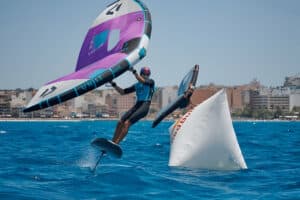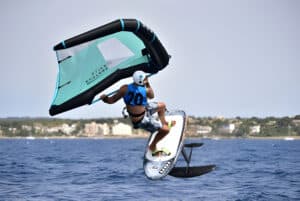Winging foiling allows riders to glide above the water’s surface, providing a unique and exhilarating experience. Winging foiling has gained popularity in recent years due to its versatility and the freedom it offers on both flat water and in ocean waves.
In this article, we’ll explore the basics of winging foiling, its equipment, and why it’s becoming a favorite among water sports enthusiasts. Whether you’re a seasoned water sports athlete or a curious beginner, understanding winging foiling can open up a new world of aquatic adventures.
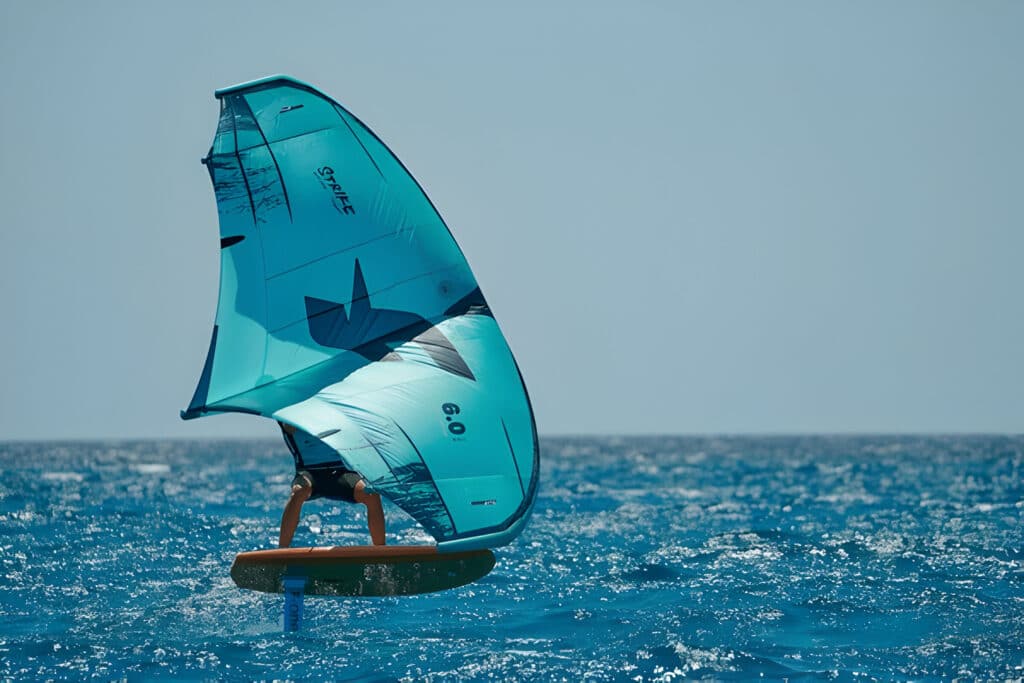
What Is Wing Foiling
Winging foiling, also known as wing foiling or wing surfing, is an exciting new water sport that combines elements of windsurfing, kitesurfing, and hydrofoiling. It involves riding a hydrofoil board while holding a handheld wing to harness wind power for propulsion.
Equipment of Wing Foiling
Wing foiling requires specialized equipment that combines elements from various watersports. The essential gear for this exciting water-based activity consists of four main components: the wing, board, foil, and safety gear.
Wing
The wing is serving as the primary means of harnessing wind power to propel the rider across the water. Modern wings used in wing foiling are typically inflatable, lightweight structures designed to be held by hand while riding.
Inflatable wings, also known as handheld wings, are made from durable materials such as ripstop nylon or dacron. These materials provide strength and rigidity when inflated while remaining lightweight. The inflatable design allows for easy transport and storage, making them convenient for riders to carry to various locations.
Wing sizes typically range from 2 to 7 square meters, with larger wings suitable for lighter winds and smaller wings for stronger winds. Beginners often start with larger wings, which provide more stability and power in lighter winds, while experienced riders may opt for smaller wings in stronger winds for increased maneuverability.
The wing’s design incorporates features to enhance performance and control:
- Leading edge: The front part of the wing that first contacts the wind, typically inflated to provide structure.
- Struts: Inflatable support structures that maintain the wing’s shape.
- Canopy: The main surface area of the wing that captures wind.
- Handles: Strategically placed grips for controlling the wing.
- Windows: Transparent sections allowing riders to see through the wing.
Board
The wing foiling board serves as the platform for the rider and the foil. These boards are typically shorter and wider than traditional windsurf boards, providing stability and maneuverability.
For beginners, a larger SUP-style board or an inflatable board is often recommended. These boards, typically ranging from 100 to 150 liters in volume, offer more stability and buoyancy, making it easier for novice riders to balance and get up on foil. The additional volume also aids in early planing, which is particularly beneficial in lighter winds.
As riders progress, they often transition to smaller, more maneuverable boards. These advanced boards, usually between 60 to 90 liters, allow for quicker turns and improved responsiveness. They’re ideal for stronger winds and more challenging water conditions.
The construction of wing foiling boards varies, with options including:
- Inflatable boards: Lightweight, portable, and durable, these are excellent for travel and storage. They’re also forgiving for beginners but may lack the performance of rigid boards.
- Epoxy boards: These offer a good balance of durability and performance. They’re lighter than traditional windsurf boards, allowing for easier pumping and getting on foil.
- Carbon fiber boards: High-performance options favored by advanced riders. They’re extremely light and stiff, providing excellent responsiveness and speed.
The shape of the board is also critical. Most wing foiling boards feature a wide nose and tail for stability, with a relatively flat rocker line to aid in early planing. The bottom shape often includes a slight concave or channel to help with tracking and release when getting on foil.
Foil
The hydrofoil is the component that allows the board to lift out of the water, creating the unique “flying” sensation of wing foiling.
It consists of several key parts:
- Mast: The vertical shaft that connects the board to the wings.
- Front Wing: The larger wing at the front that generates most of the lift.
- Rear Wing (Stabilizer): A smaller wing at the back that helps with stability and control.
- Fuselage: The horizontal component that connects the front and rear wings.
Foils for wing foiling are typically made from carbon fiber or aluminum, with carbon fiber being lighter but more expensive. The size and shape of the foil significantly impact performance:
- Larger front wings provide more lift at slower speeds, making them ideal for beginners and lighter wind conditions.
- Smaller front wings offer less drag and higher top speeds, suitable for more experienced riders and stronger winds.
Safety Gear
The right safety gear not only protects riders but also enhances their confidence on the water.
- Personal Flotation Device (PFD): A Coast Guard-approved PFD is crucial for all water sports, including wing foiling. Choose a low-profile design that allows freedom of movement while providing buoyancy.
- Helmet: Protect your head from potential impacts with the board, foil, or water surface. Opt for a lightweight, water-specific helmet designed for watersports.
- Impact Vest: This provides additional buoyancy and protection for your torso. Look for a vest that’s comfortable and doesn’t restrict movement.
For beginners and those learning in light winds, additional safety gear may include:
- Larger, more stable board for easier balance
- Inflatable wing for softer impacts
- Foam-covered hydrofoil to minimize injury risk
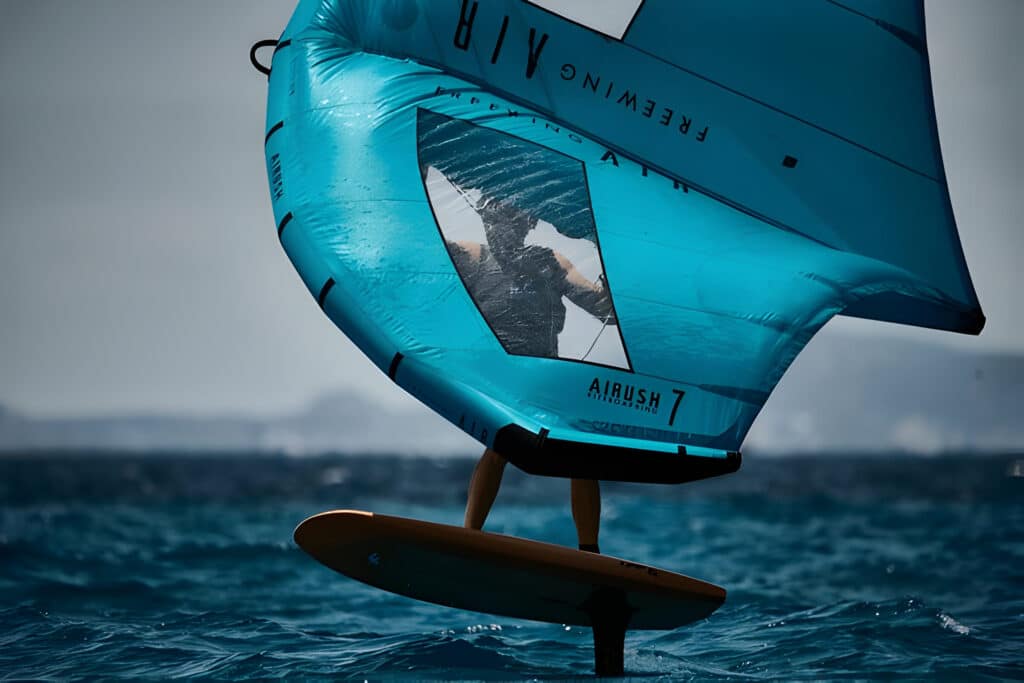
How Wing Foiling Works
To propel themselves, riders use a handheld wing, which is essentially a smaller version of a kite. The wing is designed with an inflatable leading edge and struts, providing structural rigidity. By holding the wing in front of them, riders harness the power of the wind, similar to how a sail functions in windsurfing. The wing’s design allows for a wide range of motion, enabling riders to control their speed and direction by adjusting the wing’s position and angle relative to the wind. As the rider gains speed, the hydrofoil begins to lift the board out of the water, reducing drag and allowing for a smooth, efficient ride.
Benefits of Wing Foiling
- Versatility across wind conditions: Wing foiling allows riders to enjoy wind power in both light and strong winds, extending the wind range and increasing time on the water compared to traditional windsurfing.
- Compact and portable equipment: Inflatable wings are lightweight and easy to transport, making it convenient for riders to travel to different locations and reducing setup time.
- Excellent full-body workout: Wing foiling engages core muscles, arms, and legs throughout the ride, improving overall fitness and coordination.
- Relatively quick learning curve: Many beginners can start experiencing the magic of wind power and gliding over water within a few sessions, thanks to larger, more stable boards used for learning.
- Adaptability to various water conditions: The sport can be enjoyed in flat water to moderate chop, allowing riders to practice in sheltered waters or venture out to more challenging environments as their skills progress.
History of Wing Foiling
Wing foiling, a relatively new watersport, has its roots in various wind-powered activities and innovative equipment designs. The concept of using handheld wings for propulsion on water can be traced back to the 1980s, but it wasn’t until recent years that the sport gained significant traction.
In the early 2010s, kiteboarding pioneer and Slingshot Kiteboarding co-founder Tony Logosz began experimenting with inflatable wings. His goal was to create a simpler, more accessible alternative to traditional windsurfing and kiteboarding. Logosz and the Slingshot team developed prototypes that combined elements of windsurf sails and kite designs, eventually leading to the creation of the modern wing foiling equipment.
In 2016, Hawaiian waterman and innovator Laird Hamilton began experimenting with a prototype wing foil setup, using a modified windsurf sail mounted on a hydrofoil board. His early designs paved the way for the development of purpose-built wing foil equipment. Around the same time, French foil manufacturer F-One released the first commercial wing foil setup, the “Swing,” which featured a inflatable wing and a dedicated foil board.
The popularity of wing foiling grew rapidly in the following years, with a variety of designs and innovations entering the market. Brands such as Naish, Duotone, and Slingshot began producing their own wing foil setups, each with unique features and performance characteristics. These advancements in equipment design, along with the sport’s accessibility and versatility, have contributed to its growth and appeal to a wide range of watersports enthusiasts.
Today, wing foiling continues to evolve, with manufacturers refining wing and foil designs to improve performance, stability, and ease of use. The sport has also gained recognition in the competitive scene, with events like the Wing Foil World Tour showcasing the skills of top athletes from around the globe. As more people discover the thrill and freedom of wing foiling, its history continues to be written by the passionate community of riders pushing the boundaries of what’s possible on the water.

How to Choose Foil
Foil Size
The foil size, typically measured in square centimeters (cm²), determines the lift and stability of the foil. Larger foils provide more lift and stability, making them ideal for beginners or riders in lighter wind conditions. Smaller foils, on the other hand, offer less lift but greater maneuverability and speed, making them suitable for more advanced riders or stronger wind conditions.
Foil Aspect Ratio
The aspect ratio of a foil refers to the ratio of the foil’s span (width) to its chord (length). High aspect ratio foils have a longer span relative to their chord, resulting in a thinner, more elongated shape. These foils are generally more efficient and provide better upwind performance. Low aspect ratio foils have a shorter span relative to their chord, resulting in a wider, more compact shape. These foils offer more stability and are more forgiving, making them a good choice for beginners or riders in choppy conditions.
Foil Material
Foils for wing foiling are typically constructed from carbon fiber, aluminum, or a combination of both. Carbon fiber foils are lightweight, stiff, and responsive, offering excellent performance but at a higher price point. Aluminum foils are more affordable and durable, making them a good option for beginners or riders on a budget. Some foils feature a combination of carbon fiber and aluminum, balancing performance and cost.
Foil Modularity
Many foils designed for wing foiling are modular, allowing riders to interchange different front and rear wings, fuselages, and masts. This modularity enables riders to customize their foil setup to suit their skill level, riding style, and the conditions they typically encounter.

How to Choose Wing
Wing Size
Smaller wings (around 3-4m) are better suited for stronger winds and more experienced riders, while larger wings (5-6m or more) are ideal for lighter winds and beginners. It’s recommended to start with a larger wing and progressively downsize as you gain experience and confidence.
Wing Shape
Higher aspect ratio wings offer more power and efficiency, making them suitable for light wind conditions and upwind riding. Lower aspect ratio wings are more maneuverable and stable, making them a good choice for beginners and wave riding. Some wings feature a dihedral shape, which enhances stability and control in gusty conditions.
Wing Construction
The construction of the wing affects its durability, performance, and price. Entry-level wings often use cheaper materials like Dacron, which is durable but heavier. Higher-end wings use lighter materials like Ripstop Nylon or Polyester, which offer better performance and reduced weight. Look for reinforced leading edges and struts for added durability, and consider the overall build quality and warranty when making your choice.
Wing Handles and Control System
The placement and design of the handles and control system on the wing can greatly impact its usability and comfort. Look for a wing with ergonomic handles that allow for easy hand placement and grip changes. Some wings feature adjustable handles or multiple handle positions to accommodate different riding styles and preferences. The control bar should be lightweight, durable, and easy to use, with a simple and reliable safety release system.
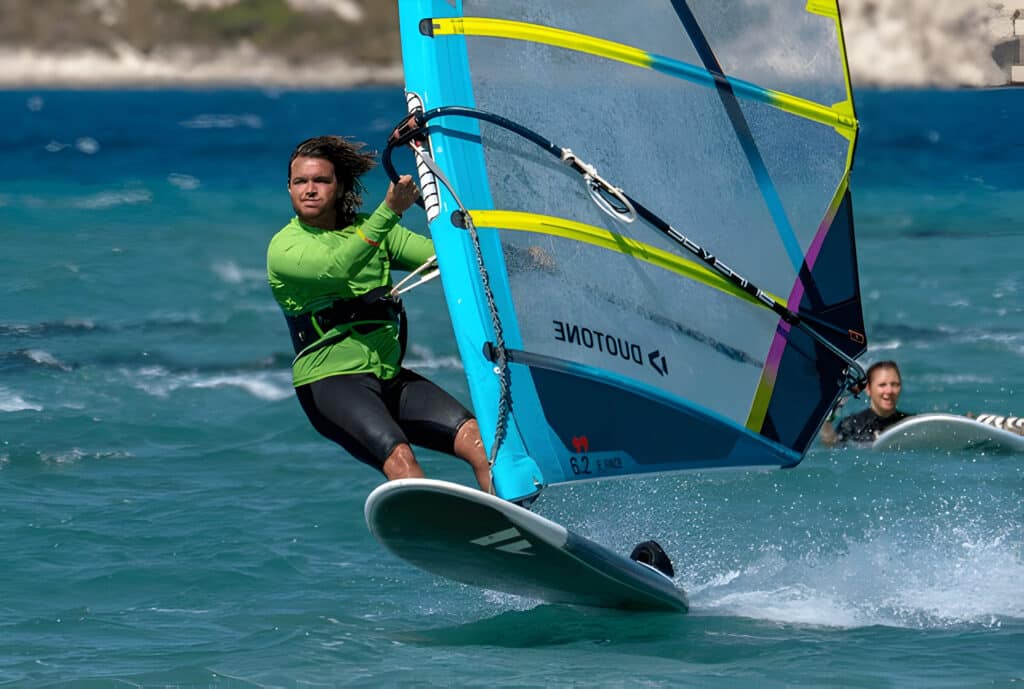
How to Choose Board
Board Size
Beginners should opt for larger, more stable boards around 75-85 liters, which offer better buoyancy and make it easier to learn the basics. As you progress, you can transition to smaller, more maneuverable boards in the 55-65 liter range. Advanced riders may prefer even smaller boards under 50 liters for optimal performance in challenging conditions.
Board Shape and Design
Wing foiling boards come in various shapes and designs, each with its own advantages. Some boards feature a parallel outline with a wide tail, providing excellent stability and early planing. Others have a more tapered outline with a narrower tail, which offers better maneuverability and speed.
The board’s rocker line (the curve of the board from nose to tail) also affects its performance. Flatter rocker lines promote early planing and stability, while more pronounced rockers enhance maneuverability and wave performance.
Construction and Materials
High-quality boards are typically made with lightweight, durable materials such as carbon fiber, epoxy resin, and EPS foam cores. These materials provide an optimal balance of strength, stiffness, and responsiveness. Some boards also incorporate special features like reinforced rails, impact-resistant nose and tail sections, and textured deck pads for improved grip and control.
Foil Compatibility
When choosing a wing foiling board, it’s essential to ensure that it is compatible with your foil setup. Most boards feature a standard US fin box that accommodates a variety of foil mounts, but some boards may have specific mounting options. Consider the type of foil you plan to use and make sure the board has the appropriate mounting system. Additionally, some boards are designed with special foil-specific features, such as recessed deck areas or channeled bottoms, which can enhance the overall performance and connection between the board and foil.
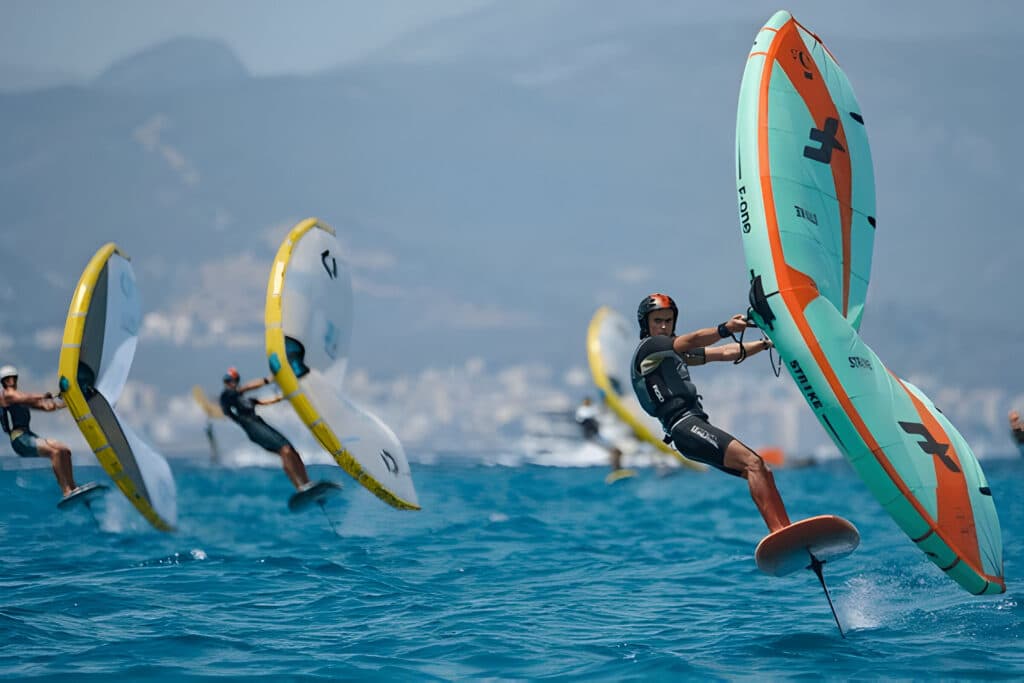
How Long Does It Take to Learn
For complete beginners with no background in water-based activities, the initial stages of wing foiling can be mastered in about 10-15 hours of practice. This includes learning to control the wing on land, getting comfortable with the board in the water, and achieving basic upwind and downwind riding.
Riders with experience in related water sports like windsurfing, kiteboarding, or surfing often progress faster. Their familiarity with wind and water dynamics can significantly reduce the learning time, potentially allowing them to achieve basic proficiency in as little as 5-10 hours of practice.
The learning process can be broken down into several stages:
- Ground training (1-2 hours): Learning to handle the inflatable wing on land.
- Water starts (2-4 hours): Practicing getting up on the board in shallow water.
- Basic riding (5-10 hours): Achieving sustained rides and simple turns in light to moderate winds.
- Foiling (10-20 hours): Transitioning from a larger SUP-style board to a foil board and learning to ride above the water.
What Are the Best Conditions for Winging
Wind Conditions
For beginners, light to moderate winds between 10-15 knots are optimal. These conditions provide enough power to get started without overwhelming novice riders. As skills improve, wing foilers can handle stronger winds up to 25 knots or more.
Light winds (8-12 knots) are suitable for experienced riders using larger wings and efficient foils. These setups allow for early planing and sustained flight in lighter wind conditions. In contrast, stronger winds (20+ knots) are ideal for smaller wings and more aggressive riding styles.
Water Conditions
Flat water is generally preferred for wing foiling, especially for beginners. Sheltered waters, such as lakes or bays, offer ideal learning environments. As riders progress, they can tackle choppy conditions and even small waves.
Water depth is crucial for wing foiling. A minimum depth of 1 meter (3 feet) is necessary to safely operate the foil without hitting the bottom. Deeper water allows for more advanced maneuvers and reduces the risk of accidents.
Wind Direction
Cross-shore winds are considered optimal for wing foiling. These winds blow perpendicular to the shoreline, providing a safe riding zone and easy return to the starting point. Onshore winds can be challenging and potentially dangerous for less experienced riders.
Temperature
While wing foiling can be enjoyed in various climates, comfortable air and water temperatures enhance the experience. Many riders prefer temperatures above 15°C (59°F) for extended sessions without the need for thick wetsuits.
Location
The best locations for wing foiling offer a combination of consistent winds and suitable water conditions. Popular spots include coastal areas with steady trade winds, large lakes, and protected bays. These locations often provide a mix of flat water and small waves, catering to different skill levels and riding preferences.
How Much Wind Do You Need to Wing or Wingfoil
For beginners, a wind speed of 12-15 knots (14-17 mph) is generally considered ideal. This moderate wind provides enough power to lift the wing and generate forward momentum without being overwhelming. As riders gain experience, they can handle stronger winds and even venture out in lighter conditions.
Intermediate to advanced wing foilers can typically ride in wind speeds ranging from 8-25 knots (9-29 mph). The lower end of this range is possible due to the efficiency of modern foil designs and the light weight of inflatable wings. In lighter winds (8-12 knots), riders often opt for larger wings, which provide more lift and power.

How Fast Is Winging
In moderate winds of 15-20 knots, experienced wing foilers can reach speeds of 15-20 knots (17-23 mph or 28-37 km/h). However, in stronger winds and with high-performance wing foiling gear, speeds can exceed 25 knots (29 mph or 46 km/h).
What Is the Difference between a Hydrofoil and Wing Foiling
A hydrofoil is a lifting surface or foil that operates in water. It’s typically attached to the bottom of a board or boat and creates lift as it moves through the water. Hydrofoiling can be applied to various water vessels, including boats, surfboards, and even water skis. The primary focus is on the underwater component that provides lift and reduces drag.
Wing foiling combines the use of a hydrofoil with a handheld inflatable wing. This sport, also known as wing surfing, involves a rider standing on a board equipped with a hydrofoil while holding and manipulating an inflatable wing to harness wind power. The wing is not attached to the board, allowing for greater maneuverability and versatility.
What Is the Difference between Wind and Wing Foiling
Wind foiling, an evolution of windsurfing, uses a traditional windsurf board equipped with a hydrofoil. The rider stands on the board and controls a sail attached to a mast and boom. This setup requires more equipment and can be more challenging to transport and set up.
Wing foiling utilizes a handheld inflatable wing and a foil board. The rider holds the wing directly, without it being attached to the board. This setup offers greater simplicity and portability, making it easier to get started and transport gear.
In terms of wind conditions, wind foiling typically requires stronger winds to get planing and lift the board out of the water. Wing foiling, however, can be enjoyed in lighter winds due to the efficiency of the foil and the ability to pump the wing for additional propulsion.
Conclusion
Wing foiling is an exhilarating water sport that combines the thrill of surfing, windsurfing, and kiteboarding into one unique experience. By understanding the essential equipment, including the wing, board, foil, and safety gear, enthusiasts can embark on an exciting journey across the water’s surface. The sport’s rich history and numerous benefits, such as improved balance and core strength, make it an attractive option for water sports enthusiasts of all levels. Whether you’re a beginner or an experienced rider, choosing the right equipment and learning proper techniques are crucial for success. With the right conditions and practice, wing foiling offers an unparalleled sense of freedom and connection with nature, allowing riders to harness the power of the wind and waves in a truly innovative way.
